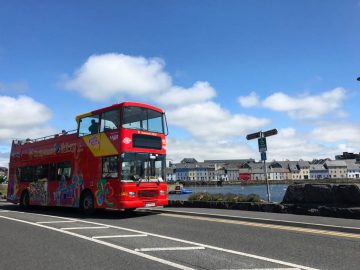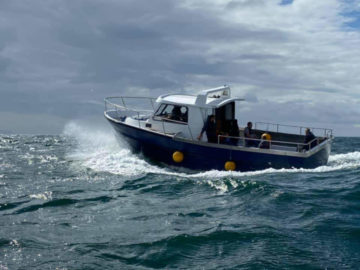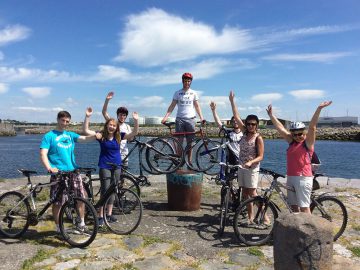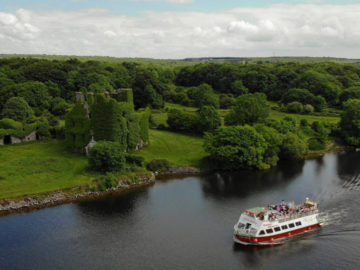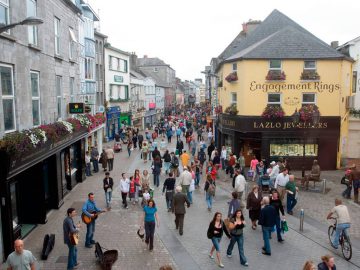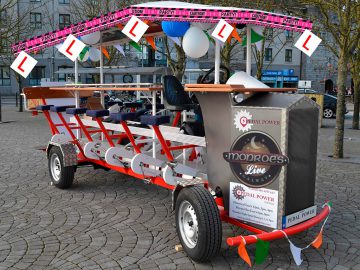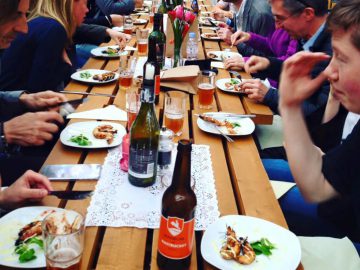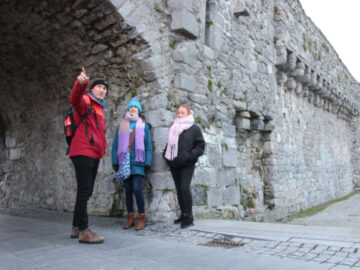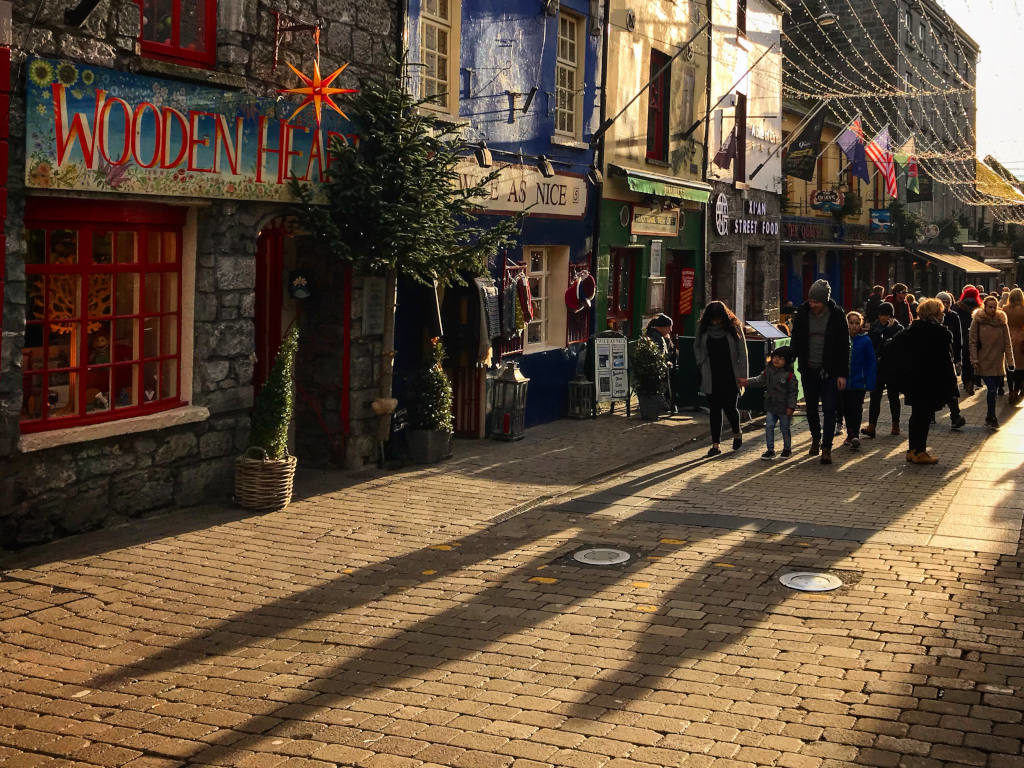
Walking Tours of Galway
Discover Galway with a guided walking tour 📸
A walking tour – what a great way to discover the rich history and cultural heritage of Galway city, and the good thing about Galway is that it’s fairly compact and easy enough to get around on foot.
Whether you choose to go with a tour company or make your own way around the cobblestone streets, it’s a great way of being part of the hustle and bustle.
Book Your Galway Walking Tour 🚶
The advantage of going on your own steam is you can stop and start as you please without feeling you are delaying the group. However a tour company would have the advantage of a guide to answer those “burning questions”, and also to add their personal touch with in-depth local knowledge.
Whichever way you choose to go and explore the city, the following should feature highly on your ”must see list”. Oh, and don’t forget a good Galway map if you’re opting for a self guided tour of the city.
A taste of what to expect in Galway
Galway City Tour Attractions
Eyre Square
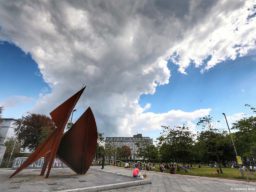 This inner city park is the focal point of Galway city. Edward Eyre, Mayor of Galway city gave the tract of land the forms Eyre Square to Galway city in 1710. Eyre Square was re-named Kennedy Memorial Park in 1965, after J.F.K. himself had visited. There is a bust of the man to be seen in the Park. Also check out the Eyre Square Centre when you’re in the area.
This inner city park is the focal point of Galway city. Edward Eyre, Mayor of Galway city gave the tract of land the forms Eyre Square to Galway city in 1710. Eyre Square was re-named Kennedy Memorial Park in 1965, after J.F.K. himself had visited. There is a bust of the man to be seen in the Park. Also check out the Eyre Square Centre when you’re in the area.
Lynch’s Castle
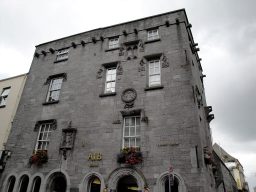 Lynch’s Castle is a historic building located in the heart of Galway City. It was built in the early 16th century by the wealthy Lynch family, who were one of the most prominent merchant families in the city at that time. The castle was originally constructed as a townhouse for the family, but it later became a courthouse, a jail, and even a warehouse.
Lynch’s Castle is a historic building located in the heart of Galway City. It was built in the early 16th century by the wealthy Lynch family, who were one of the most prominent merchant families in the city at that time. The castle was originally constructed as a townhouse for the family, but it later became a courthouse, a jail, and even a warehouse.
The castle is an excellent example of the Gothic Revival architectural style, and it features many intricate details and carvings, including a beautiful limestone façade with decorative gargoyles and a carved coat of arms. The castle is also known for its distinctive Flemish-style stepped gables, which are a unique feature in Irish architecture.
Today, Lynch’s Castle is a popular tourist attraction and is home to a bank and various commercial businesses. The building has been beautifully restored and preserved over the years, and it remains one of the most iconic landmarks in Galway City. Visitors can take guided tours of the castle to learn more about its fascinating history and architecture, and they can also enjoy the beautiful views of the city from its rooftop terrace.
Home of Nora Barnacle
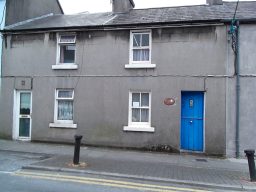 Number 8 Bowling Green was once the home of James Joyce’s wife, Nora Barnacle, just a short walk from Galway city’s main square, Eyre Square. Nora Barnacle was born and raised in Galway, and she met James Joyce while he was teaching at a nearby school in 1904. The couple fell in love and eventually left Ireland to live abroad, but they returned to Galway several times throughout their lives, and Nora lived in the house on Bowling Green for many years after Joyce’s death.
Number 8 Bowling Green was once the home of James Joyce’s wife, Nora Barnacle, just a short walk from Galway city’s main square, Eyre Square. Nora Barnacle was born and raised in Galway, and she met James Joyce while he was teaching at a nearby school in 1904. The couple fell in love and eventually left Ireland to live abroad, but they returned to Galway several times throughout their lives, and Nora lived in the house on Bowling Green for many years after Joyce’s death.
Today, the house has been restored to its original condition and is on occasion open to visitors as a museum. The museum features exhibits on the lives of Nora and James, and it contains many personal items and mementos from their time in Galway and beyond. Visitors can explore the various rooms of the house, including the bedroom where Nora was born, the kitchen where she cooked for Joyce, and the sitting room where the couple entertained friends and family.
Quay Street and the Spanish Arch
Quay Street is home to two of Galway city’s best known pubs, The Quays and Tigh Neachtain. Tigh Neachtain takes you back to the Ireland of by gone days with “old style snugs”. Enjoy “trad” music sessions at The Quays.
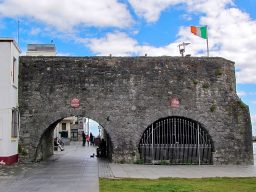 Those from near and far have heard about Galway’s Spanish Arch. Located where Galway’s River Corrib meets the sea, this is a tranquil spot. The remainder of a 16th century bastion, the Arch added to the town’s walls to protect merchant ships from looting. The Spanish Arch is so called due to Galway’s merchant trade with Spain, whose Galleons often docked under its protection. On leaving Galway, you certainly won’t forget the beautiful Spanish Arch!
Those from near and far have heard about Galway’s Spanish Arch. Located where Galway’s River Corrib meets the sea, this is a tranquil spot. The remainder of a 16th century bastion, the Arch added to the town’s walls to protect merchant ships from looting. The Spanish Arch is so called due to Galway’s merchant trade with Spain, whose Galleons often docked under its protection. On leaving Galway, you certainly won’t forget the beautiful Spanish Arch!
Claddagh Village
 During medieval times the occupants of Galway city were driven out to this area by the Normans. Down through the centuries, the inhabitants had their own customs, dress, laws and language. However in 1937, the thatched cottages of this area were demolished and new housing built in its place, thus wiping out, without trace a community’s identity and a vital part of the city’s history. The neighborhood is also famous for its traditional Claddagh ring, a type of Irish ring that features two hands holding a heart, topped with a crown. The ring is a symbol of love, loyalty, and friendship and is often given as a gift or worn as a wedding ring. The area has a long and fascinating history, and it was once a self-governing community with its own laws and customs. Today, visitors to the Claddagh can take a stroll along the quays, which offers stunning views of the River Corrib, the Spanish Arch, Long Walk and Nimmos Pier.
During medieval times the occupants of Galway city were driven out to this area by the Normans. Down through the centuries, the inhabitants had their own customs, dress, laws and language. However in 1937, the thatched cottages of this area were demolished and new housing built in its place, thus wiping out, without trace a community’s identity and a vital part of the city’s history. The neighborhood is also famous for its traditional Claddagh ring, a type of Irish ring that features two hands holding a heart, topped with a crown. The ring is a symbol of love, loyalty, and friendship and is often given as a gift or worn as a wedding ring. The area has a long and fascinating history, and it was once a self-governing community with its own laws and customs. Today, visitors to the Claddagh can take a stroll along the quays, which offers stunning views of the River Corrib, the Spanish Arch, Long Walk and Nimmos Pier.
Collegiate Church of St. Nicholas
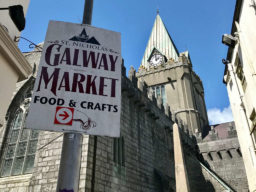
This church is located in the medieval centre of Galway city. The building of the church of St. Nicholas dates back to about the 1300′s and was built in honour of St. Nicholas of Myra. It’s a unique building, as it holds the title of being the biggest medieval church in Ireland that’s still in use. This 14th century church was built using local materials–limestone and Connemara marble. The church was used as a stables during Oliver Cromwell’s reign but other than that it has served Galway city folk well as a house of worship over hundreds of years.
Galway City Courthouse
This really is a magnificent building. Work began on the project in 1812 and the courthouse was first opened for business in 1815.
Galway Cathedral
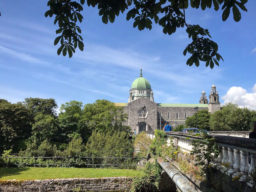
Building of the Galway Cathedral began in 1958 and the Cathedral was dedicated in 1965. The Cathedral was actually built on the site of the old county jail. The copper dome can be seen for miles and almost everything used in the building was sourced locally. It was designed by Robinson Keefe and is a mix of Romanesque and Renaissance styles with a Spanish influence as well.
Walk Galway’s waterways
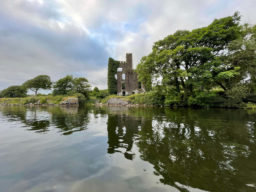
Galway is a city with rivers and canals running through it; in fact, the Corrib is one of Europe’s shortest rivers. Despite being only 6 kilometers long, it is a strong force. On this river, you can actually go kayaking if you’re up for it. If not, taking a stroll along the Corrib or one of the many canals is a wonderful way to unwind after all the activity in the city. The tranquil areas of Galway City are without a doubt the canals.
University of Galway
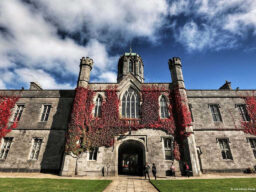
University of Galway is a truly magical location. It looks like a hybrid between contemporary Galway and a Harry Potter film backdrop. The university walled grounds by the scenic River Corrib are a tranquil oasis of greenery and nature near the city centre. It is especially beautiful in autumn when the green vines clinging to its facade turn red.
Walking Tour Guides
Great Guides of Galway
Tel: +353 (0)86 7274888
Email: [email protected]
Galway Tours
Tel: +353 (0)86 8873377
Web: www.galwaytours.ie
Galway Walks with Brian Nolan
Tel: +353 (0)86 3273560
Web: www.galwaywalks.com
Galway On Foot with Séan Leonard
Tel: +353 (0)85 7302488
Web: www.galwayonfoot.ie
